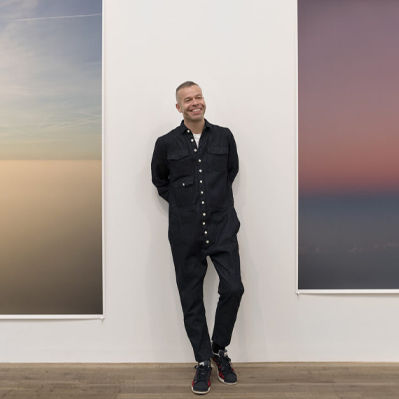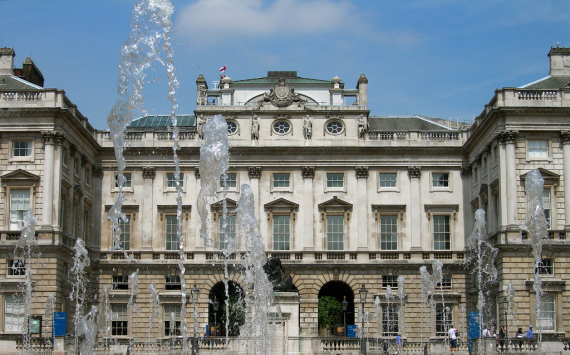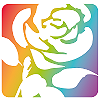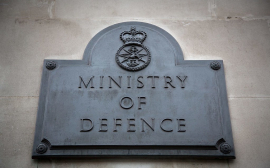- 1. Life and career
- 1.1. Beginnings
- 1.2. "Pictures, in order to see the world"
- 1.3. Grids
- 1.4. Abstractions
- 1.5. Photocopies
- 1.6. Table works ("truth study center")[edit]
- 1.7. Videos
- 1.8. Commissions
- 1.9. Music and art collaboration

Biography
Wolfgang Tillmans is a German photographer. His diverse body of work is distinguished by observation of his surroundings and an ongoing investigation of the photographic medium’s foundations.
Tillmans was the first photographer – and also the first non-British person – to be awarded the Tate annual Turner Prize. He has also been awarded the Hasselblad Award, the Royal Photographic Society's Centenary Medal, the Royal Academy Summer Exhibition's Charles Wollaston Award, The Culture Prize of the German Society for Photography, and is an Academician of the Royal Academy of Arts, London. Tillmans lives in Berlin and London.
Life and career
Tillmans was born in 1968 in Remscheid in the German area of Bergisches Land. At the age of 14 to 16, visits to museums in Düsseldorf and to the Museum Ludwig in Cologne acquainted him with the photo-based art of Gerhard Richter, Sigmar Polke, Robert Rauschenberg and Andy Warhol, which counts among his earliest influences. During his first visit to England as an exchange student in 1983, he discovered the British youth culture and the local fashion and music magazines of the time. From 1987 to 1990, he lived in Hamburg; there, in 1988, he had his first solo exhibitions, at Café Gnosa, Fabrik-Foto-Forum, and Front. From 1990 through 1992, he studied at Bournemouth and Poole College of Art and Design (now Arts University Bournemouth) in southern England. After his studies he moved to London and then to New York in 1994 for a year, where he met the German painter Jochen Klein. After moving back to England, Tillmans lived with Klein until Klein died of AIDS-related complications in 1997.
From 1995, Tillmans primarily lived and worked in London. During the summer of 1998, Tillmans participated in a month-long residency at the last active Shaker community in the world, in Sabbathday Lake, Maine.[8] Since 2007, he has divided his time between Berlin and London. Following a guest professorship at the Hochschule für bildende Kunst in Hamburg from 1998 to 1999 and an Honorary Fellowship at the Arts University Bournemouth in 2001, Tillmans was a professor for Interdisciplinary Art at the Städelschule in Frankfurt am Main from 2003 to 2006.
In 2011, Tillmans travelled to Haiti with the charity Christian Aid to document reconstruction work after the country's devastating earthquake one year before.
Between 2009 and 2014 Tillmans served as an Artist Trustee of the Tate Board. He is also a member of the museum's Collection Committee and the Tate Britain Council. In 2017, he was elected to the Council of the Institute of Contemporary Arts (ICA); in 2019, he was appointed the chair of the board.
Beginnings
Tillmans was initially known for his seemingly casual, sometimes snapshot-like portraits of friends (most notably, fashion designer Lutz Huelle and fellow artist Alexandra Bircken) and other youth in his immediate surroundings and scene. His photos – from the Europride in London (1992) or the Love Parade in Berlin (1992), for example – appeared in magazines such as i-D, Spex, Interview, SZ Magazin and Butt, and established his reputation as a prominent witness of a contemporary social movement. He was made co-editor of Spex in 1997. For the Index Magazine, he shot covers and assignments, including images of John Waters, Gilbert & George, and Udo Kier.
Tillmans was considered the “documentarian of his generation, especially that of the London club and gay scenes”[citation needed] (though he has said "It was never my intention to be seen as diaristic or autobiographical. I was not recording the world around me or my tribe or whatever. There is a big misunderstanding there that still persists to this day."). Half of his work is staged, with the artist choosing the clothes and the location, as well as setting his models up in their positions. The series of his friends Lutz and Alex, also published in i-D in 1992, are considered important photographic documents of the 1990s. In his early photographs of people, Tillmans portrayed freedom in a different way and he says: "I wanted to somehow represent what was not being represented elsewhere." From 1992 to 1994 Tillmans lived and worked in London, moving to New York in 1994. During this time, he began to show more frequently, developing an exhibition style that consisted of nonhierarchical arrangements of unframed photographs pinned or taped onto the gallery’s walls. Color photographs are placed next to inkjet prints and next to postcards and magazine clippings of his own images, reaching almost to the ceiling and the floor. He views each exhibition as a site-specific installation, often addressing the exhibition space as a larger composition.
"Pictures, in order to see the world"
Tillmans’ photographic practice subsequently developed to encompass a wide array of genres. His portraits, still lifes, sky photographs (e.g. the Concorde series), astrophotography, aerial shots and landscapes are motivated equally by aesthetic and political interests, especially related to homosexuality and gender identity. Tillmans says of his work: “I take pictures, in order to see the world.” He produces images for installations in three sizes, from small to very large, and either in signed, mounted prints, which must be protected in a frame, or as replaceable inkjet prints that can be attached directly to the wall (the latter generated by a certificate-authenticated optical disc). They are installed in meticulous wall installations, sometimes combined with photocopies, and magazine and newspaper clippings (for example, in the installation “Soldiers – The Nineties”); or presented in vitrines, arranged in extensive table-installations (“truth study center”). Operating on the basis of the fundamental equality of all motifs and supports, through this continual re-arranging, repositioning, questioning and reinforcement, Tillmans avoids ascribing any ‘conclusions’ to his work and thus subjects his photographic vision to a perpetual re-contextualization.
In 2009, after Tillmans had been using an analog 50 mm Contax SLR camera almost exclusively for over two decades, he turned to digital photography. In 2012, he abandoned film altogether and became a full-time digital photographer. In an interview that year, he describes the corresponding change from using viewfinders to integrated camera monitors as "completely turning on its head the psychology of photography, which has always been a dialogue between photographer, object and the imaginary image that one is envisioning, thinking, hoping for." According to Tillmans, the higher resolution of digital photographs correlates to "a transformation in the whole world"; he further explains: "In recent years, everything has become HD, so I think it is inevitable that the overwhelming nature of this information density is reflected in my images. In this way, they again describe quite well my sense of perception today."
Wolfgang has a passion and love for the streets and the club. Which this two inspire him in his work along with his work in the gay movement rights.(Jobey, 2010).
Grids
The 56 photographs of equal dimensions that make up the Concorde Grid were taken in and around London as part of a commission for Tillmans’ exhibition at Chisenhale Gallery in 1997. Shot from a wide range of places, including private gardens, parks, railway tracks, and the perimeter fence around Heathrow airport, they record the daily passing of the airplane. Total Solar Eclipse Grid (1998), a set of which was included in his Turner Prize installation and is now in the permanent collection of the Tate, documents the spectacle of a solar eclipse. Each of the 21 photographs in the grid was taken during the eclipse of his immediate surroundings in a tropical locale, with varying degrees of light and detail. Snow/Ice Grid (1999) is a grid of images of trampled and melting ice and snow.
Abstractions
Tillmans exhibited his first abstract and damaged pictures as a Parkett edition in 1998. The edition, 60 unique works on color-negative photographic paper collected by the artist since he began colour printing in 1990, was a combination of true darkroom mistakes and years of darkroom experimentation that they inspired. The Silver works, which Tillmans has been creating since 1998, reflect the reaction of the photographic paper to light, as well as mechanical and chemical processes. The name Silver arises from the dirt traces and silver salt stains that remain on the paper when the artist develops the photographs in a machine that is filled with water and has not been completely cleaned.
Since 2000, Tillmans has become increasingly interested in the chemical foundations of photographic material, as well as its haptic and spatial possibilities. The "Conquistador" series of photographs were the first of these interventions to be exhibited. Later works created directly in the darkroom without the use of a camera, and often largely accidental (e.g. "Blushes," "Mental Pictures," and "Freischwimmer"), present photography as a self-referential medium – one that could serve as an experimental ground for the creation of a new type of image structure. These “abstract” works now appear next to the figurative photographs. In "Blushes," fine, thread-like lines, apparently drawn with light, swim over the surface of the photographic paper, and create delicate, fluid patterns.
Tillmans further explores the bounds of photography as a medium in his “paper drop” series (2001–8). He started to make ‘paper drop’ images depicting photographic paper specifically exposed to coloured light in his darkroom in 2001. He creates extraordinary sculptural forms in photographic paper; then, by photographing them, returns them to the accustomed flatness of that medium. Photography’s step from ‘picture’ to ‘object’ is best demonstrated in the works from the “Lighter” Series (2005–8), in which the artist dropped the act of photographing and allowed the photographs - in their three-dimensional form – to only represent themselves, recalling his ongoing series "Impossible Color" (1996–present). These colourful photo-paper works are folded, creased or otherwise manipulated, allowing for a subtle play with the material surface and the resulting illusion of lines and contrast. Contained under plexiglas lids, they have a rather sculptural quality.
Photocopies
Tillman's first exhibition in 1988 was composed exclusively of images that were created with the latest kind of monochrome laser copier. He regards these so-called Approach pictures (1987–1988) as his "first work before he even owned a camera." Over the years, Tillmans has often returned to this medium. The ways that surface structure and image depth influence each other is shown in his large-format works whose original material is analogue photocopies (ongoing since 2006). Here he also references his earlier works from the end of the 1980s that he began in the course of experimenting with an old Canon photocopier. The uncontrolled contrasts and pigment particles in the images from these old machines are clear only after drastic enlargement (framed ca. 260 x 180 cm). The resulting effects are distanced but also concrete – created through not only the materiality of the printing process but also the play and variation of scale. With the analogue photocopy – probably the most ephemeral form of image (re)production – a system of values for images is brought into a critical light.
Commissioned by Tate Modern, Tillmans was on-site throughout the development of the museum's The Tanks galleries from 2012 until 2016, capturing each stage in a series of 176 shots. Turning his lens on building paraphernalia like scaffolding, walkie-talkies and sacks of cement, he manipulated his shots on an old photocopier that produces a single colour image after scanning a picture four times, ‘distorting and shifting the colours so that each one is a unique work’.
Table works ("truth study center")[edit]
In 2005, at his major supporter Maureen Paley's gallery, Tillmans showed his large-scale display-case installation Truth Study Center. Going even further than his wall-installations, Tillmans’ table works combine a diverse array of image formats and content. His own photographs are presented and arranged under glass next to extracts from books, newspapers, magazines, postcards, packaging and other found materials. The collage-like arrangements of the table displays produce an open-ness and potentiality in terms of aesthetics and content, while raising a critical question about the interpretive possibilities of the visible in a global information-society. With that, claims of absolute (in particular, religious) truth are caricatured, as if Tillmans would like to put them to a kind of test (“truth study center”). The works draw attention to the exercise of power behind the ideologies of Islamic fundamentalism, Catholicism, and capitalism.
Videos
In 1987, Tillmans began making videos, and he has exhibited them since 2002. In most, the camera barely moves, the sound is direct, and the only cuts occur when the camera is turned on and off. Lights (Body) (2000–2002), a video installation featuring static shots of the light effects inside an empty dance club, with the bass pulse of the ‘Hacker Remix' of ‘Don't be Light' by Air,[41] is the first work by the photographer using the medium of film. The only indications of people on the crowded dance floor are the subtle vibrations and occasionally visible particles of dust. In 2002, Tillmans filmed a video clip for the pop band Pet Shop Boys’ single "Home and Dry," composed almost entirely of shots documenting the mice living in the London Underground system. The film Kopierer (2010) depicts an open color laser copy machine, the CLC 1100, in the act of copying documents over a period of ten minutes.
Commissions
In 2001, Tillmans was awarded first prize in the competition for the design of the AIDS memorial for the City of Munich, whereupon the memorial was erected after his designs at the Sendlinger Tor.
In 2015, he was commissioned with creating the official portrait of retiring British Museum director Neil MacGregor, which was subsequently acquired by the museum as the first photograph portrait in a tradition stretching back 250 years.
Music and art collaboration
In 2011, Tillmans collaborated with The Opiates by offering a range of photographs to accompany their Hollywood under the knife album and Rainy Days and Remixes EP.
A fan of the 1980s experimental synthpop group Colourbox, Tillmans curated an exhibition dedicated to the group, Music of the Band (1982 - 1987), at his Between Bridges gallery in 2014, and also selected the track list and provided original artwork for a tie-in compilation of the same name. The exhibition was the first to be held in the gallery's dedicated Playback Room, where visitors can listen to Tillmans' music selections on high-end speakers.
In 2016, Tillmans' track "Device Control" was included on American singer and rapper Frank Ocean's video album Endless. After Ocean met with Tillmans to discuss the use of his photography for Ocean's studio album Blonde, Tillmans sent Ocean two of his tracks after piquing his interest. Ocean later asked if he could sample the track, to which Tillmans agreed. Although Ocean was initially planning to only sample "Device Control", it was released in its entirety as an opening and ending of the video album.























































